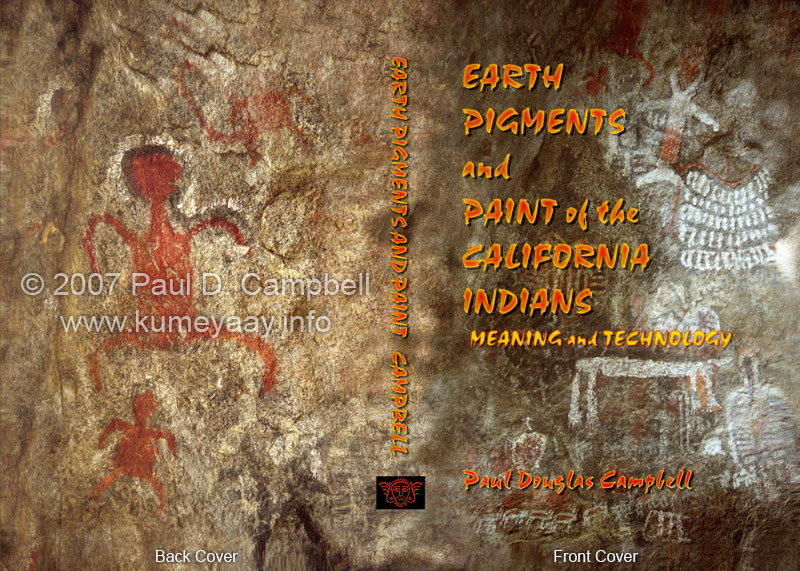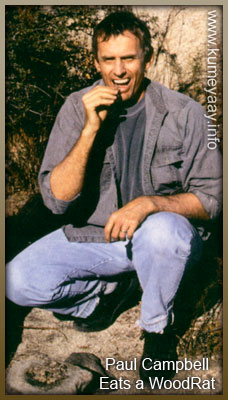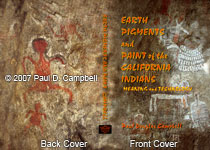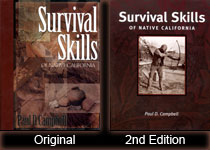|
Alarcon, Hernando de.
‘The relation of the navigation
and discovery...’ in
Richard Hakluyt, The Principal
Navigation, Voyages,
Traffiques & Discoveries of
the English Nation, vol. 9.
James MacLehose and sons.
Glasgow, 1904.
Backes, Jr., Clarus J.
‘More Than Meets the Eye:
Fluorescence Photography
for Enhanced Analysis of
Pictographs.’ Journal of
California and Great Basin
Anthropology, 24/2. Malki
Museum Press. Morongo
Indian Reservation,
Banning, 2004.
Bahn,Paul and JeanVertut.
Images of the Ice Age. Facts
on file. New York, 1988.
Barham, Lawrence.
‘From Art and Tools Came
Human Origins’ in British
Archaeology 42. March,
1999.
Barrett, Samuel A.
‘Ceremonies of the Pomo
Indians’ in University of
California Publications in
American Archaeology and
Ethnology 12(10). Berkeley,
1917.
Bean, Lowell John, ed.
California Indian Shamanism.
Ballena Press. Menlo
Park, 1992.
Bibby, Brian.
Precious Cargo: California
Indian Cradle Baskets and
Childbirth Traditions. Marin
Museum of the American
Indian. Novato, California,
2004.
Blackburn, Thomas C.
‘A Manuscript Account of
the Ventureño Chumash.’
UCLA Archaeological
Survey Annual Report,
1962-1963. Los Angeles,
1963.
_________________.
‘A Query Regarding the
Possible Hallucinogenic
Effects of Ant Ingestion in
South-Central California.’
Journal of California
Anthropology 3(2). 1976.
Blackburn, Thomas C.
and Travis Hudson.
Times Flotsam: Overseas
Collections of California
Indian Material Culture.
Santa Barbara Museum of
Natural History.
Santa Barbara, 1990.
Bolton, Herbert Eugene,
trans. and ed.
Font’s Complete Diary. University
of California Press.
Berkeley, 1931.
Breschini, Gary S. and
Trudy Haversat.
The Esselen Indians of the
Big Sur Country: The Land
and the People. Coyote
Press. Salinas, 2004.
Brill, T. B.
Light: Its Interaction with
Art and Antiquities. Plenum
Press. New
York, 1980.
Campbell, Paul D.
Survival Skills of Native
California. Gibbs Smith,
Publisher. Layton,
Utah, 1999.
Castro Silva, Tonatiuh.
Cucapá: Esbozo de una
Cultura Minoritaria
en un Espacio Fronteriza.
Pronatura Sonora.
Hermosillo, Sonora, Mexico,
2000.
Chaffee, Scott D., Marian
Hyman, Marvin W.
Rowe, Nancy Coulam,
Alan Schroedl and
Kathleen Hogue.
‘Radiocarbon Dates on the
All American Man Pictograph’
in American Antiquity
59(4). 1994.
Chittenden, Newton H.
‘Among the Cocopahs’ in
Land of Sunshine 14(3).
Los Angeles, 1901.
Christensen, Don D. and
Jerry Dickey.
‘The Pictographs of the
Eastern Mojave Desert of
California and Nevada:
An Initial Investigation’ in
Pacific Coast Archaeological
Society Quarterly 32(2-3).
1996.
Cloudman, H. C., Emile
Huguemin, F. J. H.
Merrille, and W. Burling
Tucker.
Mines and Mineral
Resources of San Bernardino
County and Tulare County.
California State Mining
Bureau. San Francisco,
1917.
Coulam, Nancy J.
‘Radiocarbon Dating of
the All American Man’ in
Canyon Legacy, Number
16. Dan O’Laurie Museum.
Moab, Utah, Winter 1992.
Coville, Frederick V.
‘The Panamint Indians
of California.’ American
Anthropologist 5(4). 1892
Crespí, Juan.
A Description of Distant Roads: Original Journals
of the First Expedition
into California, 1769-
1770. Edited and translated
by Alan K. Brown. San Diego
State University Press.
San Diego, 2001.
Crosby, Harry W.
The Cave Paintings of Baja
California: Discovering the
Great Murals of an Unknown
People. Sunbelt Publications.
San Diego, California,
1997.
Davis, C. Alan and Gerald
A. Smith.
Newberry Cave. San Bernardino
County Museum
Association. Redlands,
California, 1981.
Devereux, George.
‘Post-partum Parental
Observances of the Mohave
Indians.’ Transactions of the
Kansas Academy of Sciences
52. 1949.
Dixon, Roland B.
‘The Shasta.’ Bulletin of
the American Museum of
Natural History.
XVII(5). New York, 1907.
Dobyns, Henry F. and
Robert C. Euler.
The Walapai People. Indian
Tribal Series.
Phoenix, 1976.
Driver, Philip.
‘Cultural Element Distributions:
VI: Southern
Sierra Nevada.’ University
of California Anthropological
Records 1(2). Berkeley,
1937.
Drucker, Philip.
‘A Karuk World-Renewal
Ceremony at Panaminik.’
University of California
Publications in American
Archaeology and Ethnology
35(3). Berkeley, 1936.
____________.
‘Cultural Element Distributions
XVII: Yuman-Piman.’
University of California
Anthropological Records,
6(3). Berkeley, 1941.
DuBois, Constance.
‘The Religion of the Luiseño
Indians of Southern California.’
University of California
Publications in American
Archaeology and Ethnology
8(3). Berkeley, 1908.
Felger, Richard Stephen,
and Mary Beck Moser.
People of the Desert and Sea:
Ethnobotany of the Seri Indians.
University of Arizona
Press. Tucson, 1985.
Forde, C. Daryle.
‘Ethnography of the Yuma
Indians.’ University of
California Publications in
American Archaeology and
Ethnology 28(4). Berkeley,
1931.
Freers, Steven M.
‘The Hand Prints at CA-RIV-
114: A Forensic and
Anthropometric Study.’
American Indian Rock Art,
27. American Rock Art
Research Association,
2001.
Furst, Jill L. and Peter T.
Furst.
Mojave Pottery, Mojave
People: the Dillingham
Collection of Mojave Ceramics.
School of American
Research Press. Santa Fe,
2001.
Garth, Thomas R.
‘Atsugewi Ethnography.’
University of California Anthropological
Records 14(2).
Berkeley, 1953.
Gayton, Anna H.
‘The Ghost Dance of 1870 in
South-Central California.’
University of California
Publications in American
Archaeology and Ethnology
28(3). Berkeley, 1930.
_____________.
‘Yokuts and Western Mono
Ethnography I: Tulare
Lake, Southern Valley, and
Central Foothill Yokuts.’
University of California Anthropological
Records 10(1).
1948.
_____________.
‘Yokuts and Western Mono
Ethnography II: Northern
Foothill Yokuts and Western
Mono.’ University of California
Anthropological Records
10(2). 1948.
Gayton, Anna H., and
Stanley S. Newman.
‘Yokuts and Western Mono
Myths.’ University of
California Anthropoplogical
Records 5 (1). 1940.
Gifford, Edward Winslow.
‘The Kamia of Imperial
Valley.’ Bureau of American
Ethnology Bulletin 97.
Washington D. C., 1931.
____________________.
‘The Cocopa.’ University of
California Publications in
American Archaeology and
Ethnology 31(5). University
of California Press. Berkeley,
1933.
Gifford, Edward W. and
Robert H. Lowie.
‘Notes on the Akwa’ala
Indians of Lower California.’
University of California
Publications in American
Archaeology and Ethnology
23. Berkeley, 1928.
Gleitman, Henry, Alan
J. Fridlund and Daniel
Reisberg.
Psychology, Sixth Edition.
W. W. Norton & Company.
New York, 2004.
Gorden, Mary.
‘An Ethnographic
Compilation of the Sources,
Composition, and Uses of
Paints by the Yokuts of the Southern San Joaquin
Valley and Sierra Nevada,
California.’ Kern County
Archaeological Society
Journal, 7. 1996
Grant, Campbell.
The Rock Paintings of the
Chumash: A Study of a
California Indian Culture.
Santa Barbara Museum of
Natural History. Santa
Barbara, 1993.
Gutiérrez Martinez, María
de la Luz.
‘Antigüedad de las murales
rupestres de la península de
Baja Clifornia.’ Arqueología
Mexicana, 10(60). 2003a.
_______________.
‘El estilo Gran Mural en la
Sierra de Guadalupe.’
Arqueología Mexicana,
11(26). 2003b.
Gutiérrez, María de la
Luz, and Justin Robert
Hyland.
Arqueología de la Sierrra de
San Francisco: dos décadas
de investigación del
fenómeno Gran Mural.
Instituto Nacional de
Antropología e Historia.
Mexico City, 2002.
Harrington, John P.
Unpublished field notes at
the Smithsonian Institution.
Washington, D.C., n.d.
_______________.
‘The Burton Mound.’ Bureau
of American Ethnology 44th
Annual Report. Smithsonian
Institution, Washington, D.
C., 1928.
_______________.
Annotations on
Chinigchinich: A Revised
and Annotated Version of
A. Robinson’s Translation of
Father Geronimo Boscana’s
Historical Account of the
Indians of the Mission San
Juan Capistrano. Fine Arts
Press. Santa Ana, 1933.
_______________.
‘Culture Element Distributions:
XIX, Central California
Coast.’ Anthropological
Records 7(1). University of
California Press. Berkeley,
1942.
Hedges, Kenneth E.
‘Painted Tablas from Northern
Baja California.’ Pacific
Coast Archaeological Society
9)1). 1973.
______________.
|
‘Southern California Rock
Art As Shamanic Art.’
American Indian Rock Art 2.
1976.
Heizer, Robert F.
‘Aboriginal Trade between
the Southwest and
California.’ Masterkey 15(5).
Highland Park, LosAngeles,
1941.
_____________.
‘Francis Drake and the
California Indians, 1579.’
University of California
Publications in American
Archaeology and Ethnology
42(3). Berkeley, 1947.
_____________.
Handbook of North American
Indians, Vol. 8: California.
Smithsonian Institution.
Washington, D.C., 1978.
Heizer, Robert F. and C.
W. Clewlow.
Prehistoric Rock Art of California,
2 vols. Ballena Press.
Ramona, California, 1973.
Heizer, Robert F. and
Albert B. Elsasser.
The Natural World of the
California Indians. University
of California Press.
Berkeley and Los Angeles,
1980.
Heizer, Robert F. and
Adan E. Treganza.
‘Mines and Quarries of the
Indians of California.’ California
Journal of Mines and
Geology 40(3). 1944.
Hibben, Frank C.
Kiva Art of the Anasazi at
Pottery Mound, New Mexico.
KC Publications. Las Vegas,
1975.
Hohenthal, Jr., WilliamD.
Tipai Ethnographic Notes:
A Baja California Indian
Community at Mid-Century.
Thomas C. Blackburn, ed.
Ballena Press. Novato,
California, 2001.
Howard, Helen.
“ ‘Blue’ in the Lewes
Group” in Early Medieval
Wall Painting and Painted
Sculpture in England.
Sharon Cather, et al., eds.
British Archaeological Reports,
Ltd. Oxford, England,
1990.
____________.
Pigments of English
Medieval Wall Painting.
Archetype Publications
Ltd. London, 2003.
Hudson, Dee T.
‘Chumash Archery Equipment.’
Ethnic Technology
Notes No. 13. San Diego
Museum of Man. San Diego,
1974.
Hudson, Travis D.
‘Sunsticks’ in Skywatchers
of Ancient California.
Bowers Museum. Santa Ana,
California, 1983.
Hudson, Travis, and
Thomas C. Blackburn.
The Material Culture of the
Chumash Interaction Sphere,
Vol. III: Clothing, Ornamentation,
and Grooming. Santa
Barbara Museum of Natural
History. Santa Barbara,
1985.
__________________.
The Material Culture of
the Chumash Interaction
Sphere, Vol. V: Manufacturing
Processes, Metrology,
and Trade. Santa Barbara Museum of Natural History.
Santa Barbara, 1987.
Hudson, Travis and
Ernest Underhay.
Crystals in the Sky: An
Intellectual Odyssey
involving Chumash
Astronomy, Cosmology, and
Rock Art. Ballena Press and
Santa Barbara Museum of
Natural History. Socorro,
New Mexico, 1978.
Hyland, Justin
‘Archaeology of Rock Art:
Recent Research in Baja
California Sur, Mexico’ in
Berkeley Archaeology, 2(1).
Fall, 1994.
Johnson, Mary Elizabeth.
Indian Legends of the
Cuyamaca Mountains.
1915.
Kelly, Isabel T.
‘Ethnography of the Surprise
Valley Paiute.’ University of
California Publications in
American Archaeology and
Ethnology 31(3). Berkeley,
1932.
Kelly, William H.
Cocopa Ethnography.
University of Arizona Press.
Tucson, 1973.
King, Linda.
‘The Medea Creek
Cemetery (LAn-243): An
Investigation of Social
Organization from Mortuary
Practices.’University of
California at Los Angeles,
Archaeological Survey Annual
Report, 11. 1969.
Koerper, Henry C. and
Roger D. Mason.
‘A Red Ochre Cogged Stone
from Orange County.’ Pacific
Coast Archaeological Society
Quarterly 34/1. 1998.
Koerper, Henry C. and
Ivan H. Strudwick.
‘Native Employment of
Mineral Pigments with Special
Reference to a Galena
Manuport from an Orange
County Rock Art Site.’
Pacific Coast Archaeological
Society Quarterly 38(4).
2002.
Koski, Randolph A., Edwin
H. McKee and David
H. Thomas.
‘Pigment Composition of
Prehistoric Pictographs of
Gatecliff Shelter, Central
Nevada.’ American
Museum Novitates 2521.
1973.
Kroeber, Alfred L.
‘A Mission Record of the
California Indians.’
University of California
Publications in American
Archaeology and Ethnology
8(1). Berkeley, 1908.
______________.
‘Elements of Culture in
Native California.’
University of California
Publications in American
Archaeology and Ethnology
13/8. Berkeley, 1922.
______________.
‘Handbook of the Indians
of California.’ Bureau of
American Ethnology, Bulletin
78. Washington, D.C.,
1925.
______________.
‘Walapai Ethnography.’
American Anthropological
Association Memoir 42.
1935.
Latta, Frank F.
Handbook of Yokuts Indians
(second edition). Bear State
Books. Santa Cruz, 1977.
____________.
Ethnographic and Linguistic
Notes. On file at the
Yosemite Research Library.
National Park Service. Yosemite
National Park, n.d.
Lee, Georgia.
‘The San Emigdio rock art
site’ in Journal of California
and Great Basin Anthropology
1. 1979.
__________.
‘The Portable Cosmos:
Effigies, Ornaments, and
Incised Stone from the
Chumash Area.’ Ballena
Press Anthropological Papers
No. 21. Ballena Press,
Socorro, New Mexico,
1981.
Lee, Georgia, William
D. Hyder and Arlene
Benson.
The Rock Art of Petroglyph
Point and Fern Cave, Lava
Beds National Monument.
Associated rock Art Consultants
for Lava Beds National
Monument. Tulelake, California,
1988.
Lewis-Williams, J. David
and Thomas A. Dowson.
‘The Signs of All Times:
Entoptic Phenomena and
Upper Palaeolithic Art.’
Current Anthropology 29.
1988.
Longinos Martinez, Jose.
California in 1729: the
Expedition of Jose Longinos
Martinez. Lesley Byrd
Simpson, Trans. Huntington
Library. San Marino, 1928.
Mayer, Ralph.
The Artist’s Handbook of
Materials and Techniques.
The Viking Press. New
York, 1957.
McKee, Edwin H. and
David H. Thomas.
‘X-Ray Diffraction Analysis
of Pictograph Pigments
from Toquima Cave, Central
Nevada.’ American Antiquity
38(1). 1973.
Meyer, Carl.
‘The Yurok of Trinidad Bay,
1851.’ In The California
Indians, second edition, eds., R. F. Heizer
and M. A. Whipple. University
of California Press.
Berkeley, 1971.
Miller, George E., and
Gary S. Hurd.
‘Neutron Activation Analysis
of an Unusual Green
Pigment.’ Rock Art Papers 9.
Ken Hedges, ed. San Diego
Museum Papers 28. 1992.
Miller, Joaquin.
Life amongst the Modocs:
Unwritten History. R.
Bentley and Son. London,
1873.
Minor, Rick.
‘Known Origins of Rock
Paintings of Southwestern
California.’ Pacific
Coast Archaeological Society
Quarterly 9(40). 1973.
Möllhausen, Baldwin.
Diary of a Journey from the
Mississippi to the Coast of
the Pacific, Vol. 2. Percy
Sinnett, trans. Londen,
1858.
Mora, P. and P. Phillipot.
La Conservation des Peintures
Murales. International
Centre for Conservation.
Rome, 1977.
Moriarty III, James
Robert
‘Ritual Plaques from
Southern California’ in
The Masterkey, 56(3).
Southwest Museum. Los
Angeles, 1982.
Moser, Christopher L.
‘Sivut Paviut: Ceremonial
Wands of the Southern
California Indians’ in
Skywatchers of Ancient
California. Bowers
Museum. Santa Ana,
California, 1983.
Murdock, Joseph and
Robert Wallace Webb.
‘Minerals of California:
Centennial Volume (1866-
1966).’ California Division
of Mines and Geology Bulletin
189. 1966.
Object cards on the Yurok
pigments of Homer Cooper
in the California Indian
ethnographic collection at
the Phoebe Hearst Museum,
University of California at
Berkeley.
Pierce, H. W.
‘Seri Blue: An Explanation’
in The Kiva 30 (2). 1964.
Pilling, Arnold.
‘The Surface Archaeology of
the Pecho Coast, San Luis
Obispo County, California.’
The Masterkey 25/6. 1951.
___________.
‘The British Museum
Collection from Near Avila,
California.’ American
Antiquity 18/2. 1952.
Plesters, Joyce.
‘Sancta Sophia, Trebizond: a
note on the materials and
technique.’ Studies in
Conservation 8. 1963.
Pope, Saxton T.
‘Yahi Archery.’ University of
California Publications in
American Archaeology and
Ethnology, 13(3). Berkeley,
1918.
____________.
‘Hunting With Ishi—The
Last Yana Indian.’ The Journal
of California
Anthropology 1(2). Malki
Museum. Banning, 1974.
Powers, Stephen.
‘Tribes of California.’
Contributions to North
American Ethnology,
Department of the Interior.
Government Printing Office.
Washington, D.C.,1877.
Price, J. A.
‘Washo Economy.’ Anthropological
Paper No. 6. Nevada
State Museum. Carson City,
1962.
Priestley, Herbert
Ingram.
A Historical, Political, and
Natural Description of
California by Pedro Fages,
Soldier of Spain. University
of California Press.
Berkeley, 1937.
Putnam, Frederick W.
|
‘Ornaments.’ Report upon
United States Geographical
Surveys West of the One
Hundredth Meridian VII.
Government Printing Office.
Washington D. C., 1879.
Ray, Verne F.
Primitive Pragmatists: The
Modoc Indians of Northern
California. University of
Washington Press. Seattle,
1963.
Rogers, Malcolm J.
‘Yuman Pottery Making.’
San Diego Museum Papers,
no.2. Ballena Press. Ramona,
1973.
Rowe, Marvin W.
‘Physical and Chemical
Analysis.’ Handbook of Rock
Art Research. David S. Whitley,
ed. Alta Mira Press.
Walnut Creek, California,
2001.
Russ, Jon, M. Hyman,
H. J. Shafer, and M.W.
Rowe.
‘Radiocarbon Dating of
Prehistoric Rock Paintings
by Selective Oxidation of
Organic Carbon’ in
Nature, 348. 1990.
Russ, Jon, M. Hyman and
M. W. Rowe.
‘Direct Radiocarbon dating
of Ancient Rock Art.’ Rock
Art Papers, 9. San Diego
Museum of Man. San Diego,
1992.
Sahagún, Fray Bernardino
de.
Florentine Codex: General History of the Things of New
Spain, Book II. Arthur J. O.
Anderson and Charles E.
Dibble, eds. School of
American Research. Santa
Fe, 1963.
Schenck, Sara M., and
Edward W. Gifford.
‘Karok Ethnobotany.’
Anthropological Records
13(6). University of
California. Berkeley, 1952.
Scott, David A. and D.
Muszynski.
The analysis of some pigment
cakes in the collection
of the Santa Barbara
Museum of natural History
(unpublished report on file).
Department of Anthropology,
Santa Barbara Museum
of Natural History. Santa
Barbara, California,1989.
Scott, David A. and
William D Hyder.
‘A study of some California
Indian rock art pigments’ in
Studies in Conservation 38.
1993.
Scott, David A., M.
Newman, M. Schilling,
M. Derrick and H. P.
Khanjian.
‘Blood as a
Binding Medium in a
Chumash Indian Pigment
Cake.’ Archaeometry 38(1).
Great Britain, 1996.
Scott, David A., D.
Doughty and C. Donnan.
‘Moche wallpainting
pigments from La Mina, Jequetepeque,
Peru.’ Studies
in Conservation 43. 1998.
Scott, David A., Stafanie
Scheerer and Daniel J.
Reeves.
‘Technical Examination of
Some Rock Art Pigments
and Encrustations from the
Chumash Indian Site of
San Emigdio, California’ in
Studies in Conservation 47.
2002.
Seton, Ernest Thompson.
The Book of Woodcraft.
Garden City Publishing.
Garden City, New York,
1912.
Shelvocke, George.
A Description of the Southernmost
Part of California.
Reprint from A voyage
around the world by way of
the South Seas, performed in
the years 1719, 20, 21, 22.
The Book Club of California.
San Francisco, 1940.
Sherwin, Janet.
‘Face and Body Painting
Practices among California
Indians.’ University of
California Archaeological
Survey Report, no. 60.
Berkeley, 1963.
Shipek, Florence Connolly.
Delfina Cuero. Ballena
Press. Menlo Park, 1991.
Silver, Constance S.
The Pictographs of Fern
Cave, Lava Beds National
Monument: Agents of Deterioration
and Prospects for
Conservation. Submitted to
the National Park Service,
Western Region Office.
Copy on file, UCLA Rock
Art Archive. 1982.
Smith, Gerald A. and
Steven M. Freers.
Fading Images: Indian
Pictographs of Western Riverside
County. Riverside
Museum Press. Riverside,
California, 1994.
Smith, Watson.
‘Kiva Mural Decorations
at Awatovi and Kawaika-a,
with a Survey of Other Wall
Paintings in the Pueblo
Southwest.’ Papers of the
Peabody Museum 37.
1952.
Sparkman, Phillip Stedman.
‘The Culture of the Luiseño
Indians.’ University of
California Publications in
American Archaeology and
Ethnology 8/4. Berkeley,
1908.
Spier, Leslie.
‘Southern Diegueño
Customs.’ University of
California Publications in
American Archaeology and
Ethnology 20(16). Berkeley,
1923.
Steward, Julian H.
‘Ethnography of the Owens
Valley Paiute.’ University of
California Publications in
American Archaeology and
Ethnology 33(3). Berkeley,
1933.
Stewart, Kenneth M.
‘Mohave Warfare.’ Southwestern
Journal of Anthropology
3(3). 1947.
Strong, William Duncan.
‘Aboriginal Society in
Southern California.’
University of California
Publications in American
Archaeology and Ethnology
26. Berkeley, 1929.
Taylor, Edith S. and William
J. Wallace.
‘Mohave Tattooing and
Face-Painting.’ Southwest
Museum Leaflets, no. 20.
Southwest Museum. Los
Angeles, 1947.
Troxel, Benine W. and
Paul K. Morton.
Mines and Mineral
Resources of Kern County,
California. California Division
of Mines and Geology.
San Francisco, 1962.
Turpin, Solveig, editor.
Shamanism and Rock Art
in North America. Rock Art
Foundation. San Antonio,
Texas, 1994.
Van Nostrand, J. and E.
M. Coulter.
California Pictorial. University
of California Press.
Berkeley, 1948.
Venegas, Miguel.
Noticia de la California y
de su Conquista Temporal y
Espiritual Año 1739, 3 vols.
Editorial Layac. Mexico,
1943-1944.
Voegelin, Erminie W.
‘Tubatulabal Ethnography.’
Anthropological Records,
vol. 2, no. 1. University of
California Press. Berkeley
and Los Angeles, 1938.
_________________.
‘Culture Element
Distributions: XX,
Northeast California.’
Anthropological Records
7(2). Berkeley and Los
Angeles, 1942.
Von Langsdorff, Georg
Heinrich.
Voyages and Travels in
Various Parts of the World
during the Years 1803,
1804, 1805, 1806 and
1807. Part II. London,
1814.
Walker, Phillip L. and
Travis Hudson.
Chumash Healing: The
Medical Practices of a
Southern California Tribe.
MS on file at the Santa
Barbara Museum of Natural
History. n. d.
_________________.
Chumash Healing:
Changing Health and
Medical Practices in an
American Indian Society.
Malki Museum Press.
Banning, California, 1993.
Wallace, William J.
Archaeological Explorations
in the Southern Section of
Anza-Borrego Desert State
Park. State of California,
Department of Parks and
Recreation. Sacramento,
1962.
_______________.
‘A Remarkable Group of
Carved Stone Objects from
Pacific Palisades.’ Pacific
Coast Archaeological Society
Quarterly 23(1). 1987.
Waterman, T. T.
‘The Religious Practices
of the Diegueño Indians’
University of California
Publications in American
Archaeology and Ethnology
8(6).1910.
Wheat, Margaret M.
Survival Arts of the Primitive
Paiutes. University of
Nevada Press. Reno, 1967.
Whitley, David S.
A Guide to Rock Art Sites
of Southern California and
Southern Nevada. Mountain
Press Publishing Company.
Missoula, Montana, 1996.
________________.
The Art of the Shaman:
Rock Art of California. The
University of Utah Press.
Salt Lake City, 2000.
Whitley, David S. and
Ronald I. Dorn.
‘Chemical and Micromorphological
Analysis of Rock
Art Pigments from the Western
Great Basin.’ Journal of
New World Archaeology 6.
1984.
Whitley, David S. and
Lawrence L Loendorf.
‘Introduction: Off the Cover
and Into the Book.’ New
Light on Old Art: Recent
Advances in Hunter-Gatherer
Rock Art Research. Whitley
and Loendorf, eds. Institute
of Archaeology, University
of California. Los Angeles,
1994.
Whitley, David S., Joseph
M. Simon and Johannes
H. N. Loubser.
‘The Carrizo Collapse: Art
and Politics in the Past’
in Festschrift for Jay von
Werlhof. 2007.
Wilber, M. E., ed. and
trans.
Duflot de Mofras’ Travels
on the Pacific Coast. 2
Volumes. Fine Arts Press.
Santa Ana, 1937.
Williams,AnitaAlvarez de.
‘Face and Body Painting in
Baja California: A Summary.’
Pacific Coast Archaeological
Society Quarterly
9(1). 1973.
Wilson, Hewitt.
‘Iron Oxide Mineral Pigments
of the United States.’
Bureau of Mines Bulletin
370. 1933.
Woody, Alanah and Oyvind
Frock.
An Experimental Approach
to Pigment Analysis—Six
Years later. Presented before
the American Rock Art
Research Association in
Sparks, Nevada, 2005.
Zigmond, Maurice L.
‘The Supernatural World of
the Kawaiisu’ in Flowers of
the Wind: Papers on Ritual,
Myth and Symbolism in
California and the Southwest,
Thomas C. Blackburn,
ed. Ballena Press. Soccorro,
New Mexico, 1977.
_______________.
Kawaiisu Mythology: An
Oral Tradition of South-
Central California. Ballena
Press. Socorro, New Mexico,
1980.
_______________.
Kawaiisu Ethnobotany.
University of Utah Press.
Salt Lake City, 1981.
|



